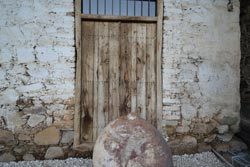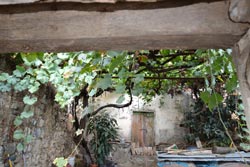Residents’ Professions
In the past, the residents of the village mainly worked as farmers and livestock breeders, while some of them also dealt with household handcrafting in order to cater for their daily needs. Therefore, one could easily characterise the community’s economy as a rural economy based on self-sufficiency.
In particular, the farmers of Oikos mainly cultivated vines and fruit gardens. The residents used grapes to produce wine, “zivania”, raisins, “soutzouko”, “kiofterka” and grape honey, which they used for pharmaceutical reasons.

The fruit gardens covered a limited expanse of land but offered a variety of goods, this way covering the nutritional needs of the residents. Apart from vegetables, fig-trees, almond and olive trees were some of the necessary trees which had to be planted by every household. In fact, the fig-pie was one of the dishes which were preserved to be eaten during the winter.
What’s more, every household bred goats which supplied them with milk used to make “halloumi” cheese, “anari”, which is a type of soft white cheese and frumenty. In fact, before the British occupation several residents were livestock breeders and dealt exclusively with their flocks. Later on, however, the British imposed a law according to which livestock breeding was prohibited because the animals ruined the flora on the island. Therefore, the residents had to make do with only a few goat sheep. Pigs were also necessary for every family since they provided the family’s meat, while donkeys were used to transfer their products from the vineyards, fruit gardens or fairs.
Fairs were a place where a lot of residents used to sell their products or better exchange them with other products. For example, they would give or sell “soutzouko” and buy or take wheat in return.

Apart from farming and livestock breeding, a lot of residents worked in the mines. The majority of them were men, with the exception of the mine of Amiandos which also employed women. Other mines towards which the residents had to walk to reach were the ones of Chromio, Mavrovouni and Foukasa, today known as Skouriotissa.
Moreover, as it has already been said, some of the residents worked at home doing some kind of home handcrafting. The women would weave on the loom to create the clothes of the family and other garments by using silk from silkworms which they themselves bred or by using thread which they would be supplied from elsewhere.
At the same time, a lot of men would work as shoemakers either fixing shoes or making new boots after processing the leather.
What is noteworthy is the fact that everything the residents did was by using their own hands, something which was really difficult and it was for this reason that they were in the habit of helping each other in whatever they had to do, such as working in the vineyards, which can in no way cater for the needs of a family today.
However, several residents continue to work in agriculture by cultivating mainly fruit-bearing tress such as peach, nectarine, cherry, apple and fig trees. Of course, cultivation methods have changed and so has the purpose of cultivating, since the commercialization of goods is what characterizes today’s economy. In general, a lot of professions which survive today are not based on the old traditional way as they have evolved and become industrialized, with one such example being the construction of the “soutzoukos” factory which was built a few years ago.
What is also a fact is that the majority of the residents work in the fields of construction, trade and transport.
Source:
Study conducted by the resident of Oikos, Eirini Charalambous |
